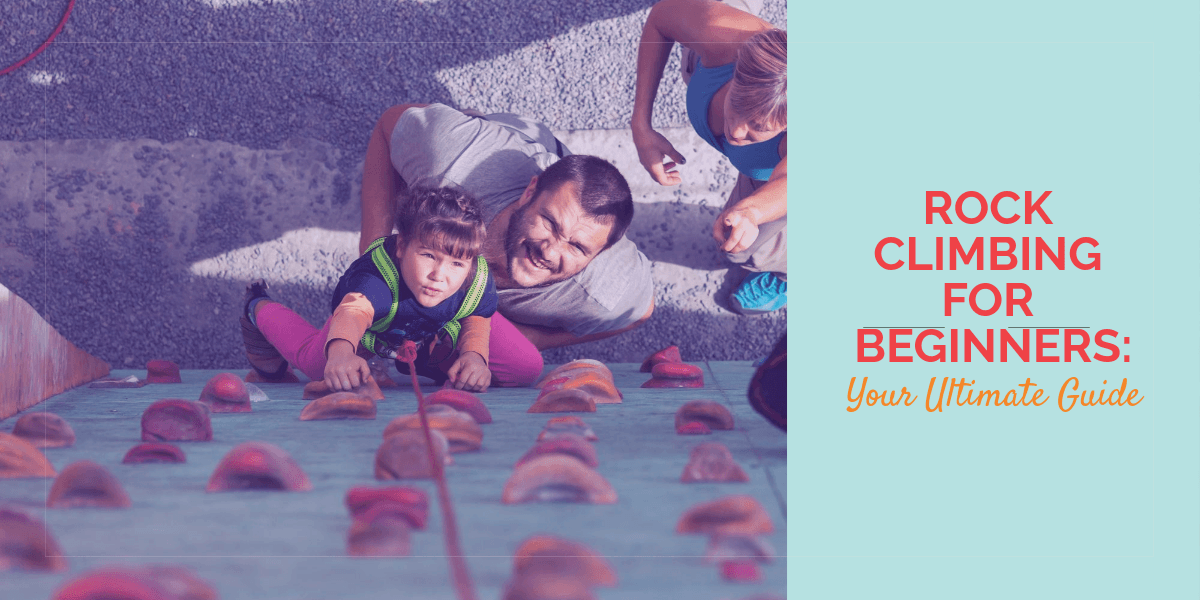Rock Climbing for Beginners: Your Ultimate Guide

If you’re looking to step up your physical fitness game in an exciting, adrenaline pumping way, then look no further. Rock climbing might be just the thing you’re looking for!
And though you might consider rock climbing a daredevil sport, it’s also great for someone just looking for a casual adventure. Anyone who is in averagely good shape can get started with rock climbing, provided they can even get ahold of the right gear and instruction as well.
Need to learn how to rock climb for beginners? This is where you should start.
Here’s Our Guide for Rock Climbing for Beginners
When to get a climbing guide
Before you start, find yourself a guide. This could be an experienced friend or a certified instructor. It’s a good idea to start here so you know what you can expect. When you start with an excellent guide, you’ll make all the next steps so much more comfortable with yourself.
Look around for your local climbing organizations. A gym might even be a right place to check for experienced climbers in your area. When you find one, talk to them about the kind of climbing they do, what gear they use, and ask any questions you might have.
From there, you can make the decisions in the next steps.
Choose a Type of Climbing
The exact kind of rock climbing you choose will determine a variety of different factors for you. There are a few different kinds of climbing, and every type of climbing comes with its own set of gear and training.
In general, beginners start out with indoor climbing. Any outdoor climbing for beginners is usually bouldering or top-rope climbing.
Indoor Climbing
Many colleges and public recreation centers have walls or freestanding structures that people can use to give climbing a try. However, you’ll probably have the best luck when you search for a climbing gym near you.
These places use artificial “rocks” as hand-and footholds. They’re placed strategically to create routes that vary in difficulty. These are easily moved around to create an endless amount of new climbs on the same structure.
If you’re a beginner, there are many reasons why an indoor climbing arena is the right choice for you. It lets you try the sport with gear that you rent rather than buy on your own, and it doesn’t require good weather for practice. It’s also ideal for anyone who lives in an area where outdoor climbing isn’t accessible.
Bouldering
Bouldering is the kind of climbing that takes the least amount of time and supplies. Bouldering usually only takes you as high as you can comfortably jump off. Climbers move alongthe rock horizontally and parallel to the ground. This is “traversing.”
Traversing allows you to work on strength and movement and it won’t expose you to a dangerous fall.
It’s an excellent activity for beginners because you only need climbing shoes, a chalk bag, a crash pad, and an experienced spotter. You don’t need ropes or harnesses.
You can find outdoor bouldering areas all around the country, but many climbing gyms offer this as well.
Outdoor Top-Rope Climbing
Top-roping requires you to anchor the climbing rope to a place at the top of the route you intend to climb, then climbing towards that anchor while someone else keeps the rope tight.
When you have a solid anchor point and a taut rope, you minimize much of the danger of a fall. Because of this, top-roping is the first kind of roped climbing you should do in either an indoor or outdoor setting.
There are other, more advanced kinds of climbing, but because this is a beginner’s guide, we’re going to leave them out. But if you’re interested in learning more, this is an excellent place to check.
Gear Up
If you choose a gym or a certified guide, the necessary equipment can usually be rented. Some gyms may require you to buy a few pieces of gear, so make sure you know what climbing gear you should get. Eventually, you’ll want to purchase your own full set of climbing gear.
Always make sure you thoroughly inspect your gear before you wear it. Whether you rent or buy, you need to make sure it doesn’t show signs of wear and tear that could be detrimental in the future.
Rock Climbing Shoes
Climbing shoes are designed to protect your feet and give you the friction you need to grip footholds tightly. They should fit snugly but not be too tight.
Climbing Helmet
When you’re outdoors, you need to wear a helmet that’s designed for climbing. They’re made to protect your head from falling rock and debris, and some are designed to help protect your noggin if you fall.
Climbing Harness
Unless you’re bouldering, you’ll need a climbing harness. They consist of a waistbelt that sits snugly over your hips and leg loops that go around each leg.
Chalk
Just like a gymnast, you’ll need chalk to amp up your gripping potential. Chalp will absorb any liquid on your hands. Carry it in a pouch around your waist.
Carabiners
Carabiners are strong, but lightweight metal rings with gates that will connect your climbing rope to different parts of your climbing protection. They’re also used to make quickdraws and to attach your gear to the loops on your harness.
Belay Device
A belay device is used to help the belayer control the rope. When used the right way, a belay device will increase the friction that will let them catch someone who is falling, or lower a climber gradually and smoothly.
Climbing Ropes
Your rope is your most important gear as a climber. When you’re starting out, your rope will probably be provided for you, but as you get better, you’ll want to know more about the rope you need to use.
Choosing a rope is too complicated for a beginner’s guide, but when you’re ready, here’s an excellent guide to start with.
But, it’s still helpful to know the two basic rope categories.
First, there’s dynamic rope. This is good for rock climbing because it has elasticity worked into it. It’s made to absorb fall energy.
Then there’s static rope. Static rope is stiff and doesn’t have the same elasticity that dynamic rope does. It’s used for rappelling and rescues.
In addition to these pieces of gear, there are also climbing protection and crash pads. Those are mostly used for more advanced climbers, so they’re not crucial for the purpose of this guide.
Choose a Route
In the US, climbers use the Yosemite Decimal Rating System to rate how difficult a climb is. The technical climbing part of the scale runs from 3.0 to 5.15, and the decimal rises as the difficulty of a specific route does.
To put it broadly, easier climbs are given a 5.1-5.5 rating. Those are usually the types of climbs you’ll start out on.
As you move through to harder routes, you’ll get into 5.6-5.10 ranges.
The rating system for bouldering is a little more varied. The V scale is the most common one used. A score of V0 is considered very easy, and a score of V16 is considered very hard.
Rock Climbing for Beginners
We hope this rock climbing for beginners guide has given you the insight you need to get started on this journey. Rock climbing is a fun, challenging way to increase your physical health and get you up and moving.





